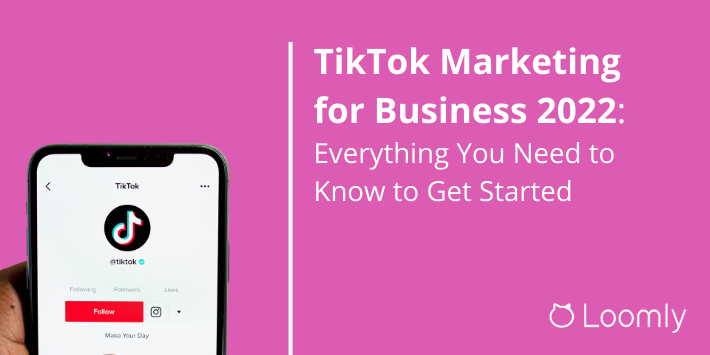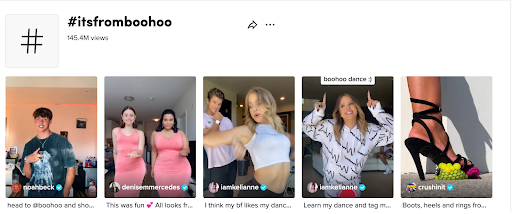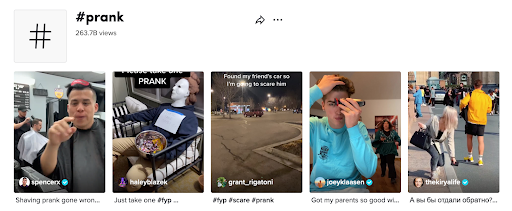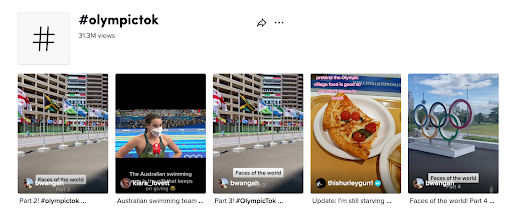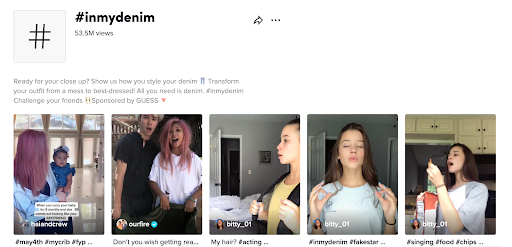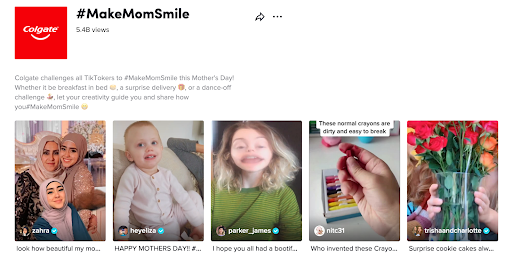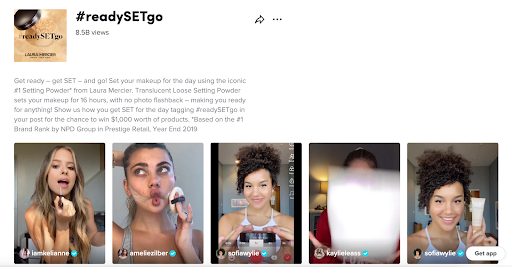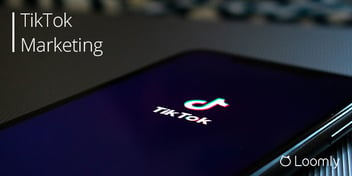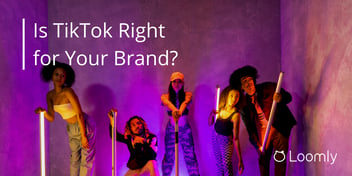TikTok marketing can take your business to new heights and help you reach a larger audience than you ever thought possible. Here’s everything you need to know to get started.
Yes, TikTok may be best known for producing a wave of Gen Z megastars who have used the platform to grow massive followings and become today’s pop-culture trendsetters. You may have heard of Dixie and Charli D’Amelio, Khaby, or JoJo Siwa to name a few.
But TikTok isn’t only one of the biggest cultural phenomena of our times, and it certainly isn’t only for teens anymore. It’s changing marketing as we know it.
With a community of 1 billion monthly active users — 92% of whom take action after watching a TikTok video — it’s a rapidly maturing marketplace where brands can grow exponentially and earn serious money.
In this guide, we’ll answer everything you need to know to get started with TikTok marketing. Ready? Let’s go.
What is TikTok?
Unless you’ve been living under a rock for the past two years, you’ve probably watched at least one TikTok viral video — if not on the platform itself, on a news website or another social media network. But, just in case, here’s a quick refresher.
TikTok is a platform where anyone can create and share looping short-form videos.
In TikTok’s original incarnation, videos could be up to 60 seconds long. TikTok extended the maximum video length to three minutes in 2021. And, starting in February 2022, it more than tripled the limit to 10-minutes.
Like Snapchat, TikTok’s interface has built-in visual effects, original sounds, and a music library. You can add filters, transitions, sounds, musical overlays, captions, and more quickly and easily from your phone – even if you’re not especially tech-savvy (or patient).
As a brand, there are endless opportunities for monetization, including:
- Selling your products or services using TikTok Shop
- Earning money for live streaming. Users can tip you with TikTok coins, which you’re able to exchange for dollars. TikTok takes a 20% cut and you, as the content creator, keep the other 80%
- Earning affiliate marketing commissions
Two apps become one: TikTok’s origin story
TikTok started out as two separate video-sharing apps: Musical.ly and ByteDance.
In 2018, ByteDance, which at the time had around 100 million followers in China and Thailand — respectable, but nowhere near Facebook, Twitter, Instagram, or YouTube numbers — bought Musical.ly. The two apps then merged and rebranded as TikTok.
Shortly after the merger, in December 2018, a clip of gummy bears singing the chorus to Adele’s “Someone like you” posted by user David Kaspřák went viral.
Now, TikTok is available in over 150 countries and 75 languages.
It has been the most downloaded app in the world for 13 straight quarters, with 2.2 billion downloads between 2019 and 2021, and a whopping 176 million downloads between January and March 2022.
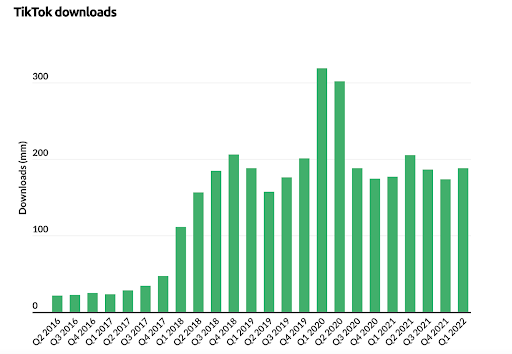
Source: Sensor Tower
Most significantly, users aren’t afraid to open their wallets for brands that catch their attention.
Since 2018, TikTok users have spent $3.7 billion on the platform, with a whopping $840 million of that spent between January and March 2022 alone. American TikTok users account for the bulk of that spending — 37%. Great news if you’re looking to monetize your content or boost your online sales in the states.
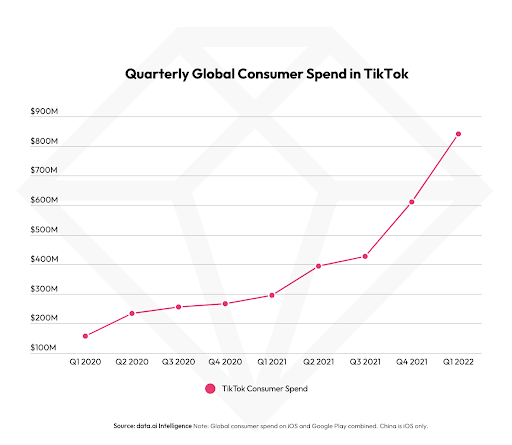
What’s popular on TikTok?
According to a Nielsen study, the single biggest reason users log on to TikTok is to “lift their spirits”.
TikTok is a hotbed of memes, humor, and viral trends. Or, as TikTok themselves put it in their LinkedIn bio, “…a place where everyone belongs… a vibrant buzzing atmosphere that celebrates trends and embraces diversity.“
As a result, the content that tends to perform best is somewhat rough and ready, authentic, and light-hearted. The five most viewed content categories on TikTok are:
1. Entertainment
This is by far the most popular — and broadest — category on TikTok. It includes
- Comedy videos, skits, and content in which users poke fun at themselves for laughs.
- Music-based content. Unsurprisingly, given TikTok’s roots as Musical.ly, lip-synch videos, original music videos, and duets — a feature that allows users to reply to a post using the same music as the original poster — do extremely well.
68% of TikTok users say they remember a brand better if it posts videos that have music they like. And 58% are more likely to share the content and talk about the brand
- Special effects. TikTok’s extensive built-in visual and sound library creates all sorts of opportunities to have fun and experiment. You can add filters, tweak the playback speed, include text, captions, and emojis, or even trigger certain sounds when you perform specific actions for cartoonish effect.
- Magic tricks. TikTok’s top magician, Zack King, has racked up over 870.6 million likes on his videos.
2. Dance
Many of TikTok’s biggest memes and viral trends involve dancing.
Typically a user, influencer, or brand posts a video in which they perform a series of moves, usually to a popular song. Other users will then post videos of themselves attempting to recreate the performance, often giving it their own twist.
Think dance trends are just silly entertainment for kids? Think again, because brands have used dance-based content on TikTok with serious success.
Clothes retailer BooHoo, for instance, created a song and dance routine and challenged users to post videos of their attempts to recreate it with the #itsfromboohoo hashtag (we’ll talk more about hashtag challenges in a minute).
To date, users have posted tens of thousands of videos, and the hashtag has been viewed over 145 million times.
3. Pranks
TikTok’s format and built-in visual effects and sound library make it the perfect platform for sharing prank videos.
To date, the #prank hashtag has racked up 263.7 billion views, and several prank videos have become memes and viral trends in their own right. For example, this “ice” prank has over 30M views:
4. Fitness & Sports
While 3 minute TikTok videos are too short for a typical full workout, celebrities and fitness influencers can build stronger connections with followers by sharing tips and tricks or demonstrating specific moves.
Dwayne “The Rock” Johnson, for instance, regularly posts clips of himself working out at the gym.
During the 2021 Olympic games in Tokyo, many athletes also turned to TikTok to share their experiences, effectively making the platform the games’ unofficial behind-the-scenes channel.
5. Home Renovations & DIY
Tips, tricks, demonstrations, hacks, before-and-afters…
DIY is huge online, so it was inevitable that it would also take off on TikTok. There are tens of thousands of home renovation videos on the platform, with 4.9 billion collective views.
Who uses TikTok?
TikTok is used by everyone, but users skew younger and female.
In April 2022, 56% of the platform’s global user base were women, while 44% were men. And, at 43.3%, those aged 18 to 24 made up the biggest chunk of the platform’s users.
That said, the user-base is growing across all age groups. There are 312 million TikTok users aged 25 to 34, 133.5 million aged 35 to 44, 67.4 million aged 45 to 54, and a not insignificant 41.7 million who are 55 years old or over.
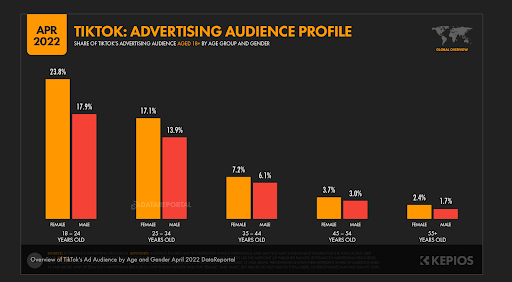
Source: datareportal.com
More to the point, the lines between age groups are increasingly blurry. Tiktok’s biggest selling point is its entertainment value, so it’s starting to become a family activity.
“Here’s what’s unique…” a blog post on TikTok for business observes, ‘…often, the whole family participates together — even teens don’t shy away. It used to be a challenge getting everyone to sit still for a photo; now we see perfectly choreographed dance routines from the whole family, including grandma.“
If you’re a brand, this means you could potentially get in front of several different demographics at the same time, at a fraction of what it would cost you on traditional advertising channels.
How do TikTok’s engagement rates compare to other platforms?
One of the biggest benefits of adding TikTok to your marketing strategy is that, compared to other social media networks, it’s relatively easy to get discovered and grow your reach organically.
According to a 2022 Conviva report, the engagement rate — the rate at which users like, comment on, or share a post — for accounts with less than 100K followers is 28%. To put that in perspective, the median engagement rate on Facebook is 0.064%, and the median engagement rate on Instagram is 0.67%.
As with other social media networks, TikTok’s engagement rate decreases the more followers you have. That said, at 10.7% for accounts with 1 to 2 million followers, it’s still impressive.
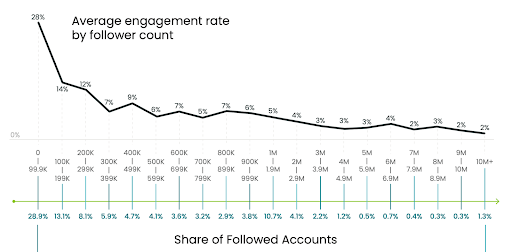
Source: Conviva
Discoverability, and growing your audience is incredibly important as well. If you commit to posting relevant, high quality content consistently, your follower count could grow exponentially. This is unfortunately not always the case on other platforms.
When Conviva looked at 1500 TikTok brand accounts between March 2021 and 2022, it found that follower counts for accounts that stuck to a regular posting schedule went up by, on average, an astounding 527K.
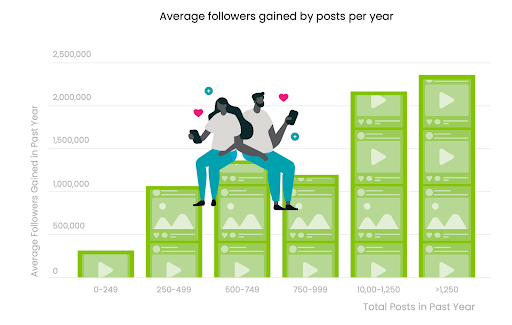
Source: Conviva
Is TikTok marketing right for my brand?
With its sky high organic reach and rapidly growing community of highly engaged users, the case for joining TikTok is certainly compelling.
However, getting started on any new social media platform is an investment, especially when video content is involved. Before you get your brand started on TikTok, it’s worth doing some soul searching.
Here are four things to consider before signing up:
1. Who is your target audience?
While TikTok is becoming more popular with people of all age groups, its users are still predominantly female Gen Z and younger Millennials. This means you’ll get the most out of the platform if you want to appeal to women under 35.
This isn’t to say you’ve no chance of succeeding if your target customers tend to skew male or older. But your results may vary.
2. Do you have the time and resources for TikTok?
As with any other marketing strategy, you get out of TikTok what you put in.
Because engagement rates are sky high, it’s fairly easy to build a community from scratch with relatively little money. But, in order to do that, you’ll need to make a consistent effort.
According to Conviva’s research, the brands that registered the biggest increases in follower counts between March 2021 and 2022 posted around 7.1 times more often than other brands.
If you’re already creating video content, you’ve won half the battle. Now you’ll just need to optimize it for TikTok.
If you aren’t producing videos on your own, it certainly doesn’t have to be DIY. There is a huge market of freelance or agency creators who will make TikToks for you.
Social Media Management Platforms like Loomly also make creating and posting content to all your social media channels easier than ever.
3. What do you sell?
At the risk of stating the obvious, TikTok works best if you’re comfortable marketing yourself on video. Highly visual products are a perfect fit.
Food subscription service Hello Fresh, for instance, often posts videos of its food being cooked. This reinforces how easy the brand makes it for anyone to prepare delicious meals even if they’re busy professionals (or the kind of people who aren’t exactly in their element in the kitchen).
That said, with some out-of-the-box thinking, you can succeed on TikTok even if your brand isn’t what people would traditionally consider ‘visual’.
Case in point, divorce attorney Marco Brown’s videos, in which he answers his followers’ burning legal questions, have racked up 813.3K likes to date:
4. What’s your brand’s vibe?
As we’ve already touched on, TikTok is, first and foremost, about authenticity and fun. As such, the best-performing content on the platform has a casual, relaxed vibe.
This doesn’t mean TikTok can’t be an option if you’re in a serious industry though.
Eileen Hollis — who runs the Hollis Funeral Home — has become a viral sensation, racking up 15.8 million likes and proving that, with the right attitude and approach, any business can succeed with TikTok marketing. Even one that sells products and services we’d rather not think about.
The key is to keep things light-hearted and not take yourself too seriously.
1. Duolingo
In the summer of 2021, language learning app Duolingo already had 30 million subscribers in Brazil. So, increasing their reach even further seemed like a tall order.
But with an innovative strategy and the clever use of TikTok hashtags, they reached 38 million new users, increased their follower count by 1400%, and, most importantly – smashed their KPIs.
The campaign involved Duolingo’s iconic owl and other characters teaching the meaning of popular TikTok hashtags like #fy, #trend, #stitch and #cringe, and inviting viewers to install the app. In just one month, the videos were viewed more than 90 million times and the click-through-rate was 39% higher than they expected.
Even if your mascot isn’t cuddly or iconic, thinking outside the box, teaching your audience something useful, and sprinkling in some humor could make you the next viral sensation.
2. e.l.f. Cosmetics
elf Cosmetics skyrocketed into popularity with their sponsored #eyeslipsfacechallenge challenge.
The brand composed an original song — Eyes, Lips, Face — inspired by Kash Doll’s ‘Ice Me Out’, which was topping the charts at the time. Before long, even celebrities like Reese Witherspoon were posting videos of their take on the song — without being paid to do so.
The ad was the first to reach TikTok’s #1 trend spot and the fastest ad to ever hit one billion views. It also broke the record for the mostuser-generated videos in a TikTok brand campaign, and all it took was finding a way to engage users, making them want to participate. How can you inspire your audience to get involved?
3. NEXT
Yes, even companies from “boring” industries like insurance can smash it on TikTok. At least, NEXT certainly did.
The company, which sells small business insurance online, partnered with TikTok creators who were also small business owners. These creators made videos in which they addressed common small business pain points from their perspective, followed by a demonstration of how NEXT solved these problems.
By the end of the campaign, NEXT was getting twenty times more leads than before and their conversion rate had increased by 11.8%.
Not every successful TiKTok marketing campaign needs to go viral or inspire celebrity involvement, and that really is the beauty of TikTok. It’s all about participating in the conversation and being your authentic self.
Which TikTok marketing strategies should I consider?
Whether you want to grow organically or go the paid route, there are several approaches you can take to marketing your brand on TikTok. The best part? These are all distinct strategies, but some of the most successful campaigns mix and match strategies to double their impact or achieve specific goals.
Here are six ways you can optimize your content so it delivers the best possible results for your brand.
1. Teach what you know
As we saw with Marco Brown, the divorce lawyer example from earlier, one of the easiest and most effective ways to get started with short-form video content is to focus on you and/or your brands’ expertise. Think: what can you teach in one minute or less about your industry or business?
According to TikTok, 35% of users say they use the app to learn something new.
This is great starting content for any brand: you get to highlight your expertise, offer unique value to your audience, and develop strong content that you can repurpose on other channels.
2. Create a hashtag challenge
As the name suggests, a hashtag challenge encourages users to shoot a video of themselves doing a specific action and posting it on TikTok with a branded hashtag.
The first ever TikTok hashtag challenge was Guess‘s #InMyDenim. To participate, users had to film themselves in unusual places wearing Guess’ new denim line, with Bebe Rexha’s “I’m A Mess” in the background.
Since then, countless hashtag challenges have taken off.
Colgate’s #MakeMomSmile campaign, which encouraged TikTok users to post videos of themselves doing something special for mom on Mother’s Day, has been viewed 5.4 billion times.
But hashtag challenges can deliver exceptional results even if they don’t go viral.
The typical hashtag challenge on TikTok has a median engagement rate of 17.5% compared to less than 1% on other platforms. And, in the consumer-packaged goods industry, over 50% of hashtag challenges generate $5 or more in revenue for every $1 spent.
Another way to kick things off when you’re just getting started is to work withinfluencers, as they can help you build momentum for your hashtag even if you don’t already have a popular TikTok channel.
3. Run a user-generated content (UGC) campaign
TikTok’s audience loves to get involved and experience products. So if you can find a way of encouraging followers and customers to share videos of themselves using or interacting with your products, you’re likely to attract more followers.
Better still, customers perceive user-generated content to be 2.4 times more authentic than branded content, because it’s made by real people. And you can do it for next to nothing — just set the parameters and your followers will do the rest. What’s not to love?
In one example, cosmetics maker Laura Mercier asked customers to post videos of themselves before and after using its products, giving the winning videos a chance to take home $1,000 worth of products.
Customers submitted over 2,500 videos, which were viewed 8.5 billion times.
4. Partner with influencers
Partnering with influencers on TikTok can be beneficial no matter how many TikTok followers your brand has. The reason they can be so successful in helping kickstart a campaign is because:
First, they put your products in front of a whole new audience.
Second, influencers are Gen Z’s third most trusted source of recommendations after family and friends. And seeing as Gen Z is the biggest demographic on TikTok, well… you know where this is going.
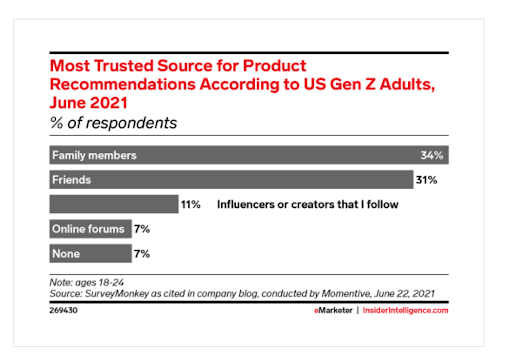
Source: eMarketer
Partnering with TikTok influencers has helped energy drink maker Bang to go from relative obscurity to the third best-selling energy drink brand in the US.
And, in many cases, the marketing isn’t even that overt.
Gil Croes, for instance, who specializes in comedic content, has made several videos where Bang is clearly visible. But the story is never about Bang. Typically, he’s just casually holding a can of Bang as he’s doing his schtick.
5. Run an advertising campaign
Where most customers have a negative perception of online ads, TikTok has found a way to buck the trend.
Research has found that an overwhelming 80% majority of TikTok users find TikTok ads enjoyable, trendsetting, and inspiring. And, more to the point, TikTok users are 10% more receptive to TikTok ads than they are to ads on other platforms.
With numbers like those, investing in TikTok ads can be well worth it.
To get started, you’ll need to create an ad account and wait for a rep to approve you.
Once you’re accepted, you can define your campaign objective, set your budget, choose who your ad should target, and get creating.
There are five main types of TikTok Ads:
Brand takeovers
These are full-screen ads that appear when a user first opens the app, like this Too Faced ‘Lip Injection Extreme’ lip gloss ad that ran in the UK. This campaign received 7.6M impressions, 1.3M clicks, with a click-through rate of 18.38% – exceeding the UK market’s benchmark.
Top view ads
Top view ads work like brand takeovers, but they don’t cover the screen as soon as a TikTok user logs in. Instead, they appear on the first in-feed post after around three seconds and show up to 60 seconds of full-screen video.
In a Kantar research study, top view ads were the preferred ad format for 72% of participants.
In-feed ads
These are native ads placed either at the bottom of TikTok videos or in the main news feed, such as this Maybelline Volum’ Express Hypercurl Mascara music video that ran in Japan.
Hashtag challenges
As we’ve discussed in previous sections, this involves encouraging users to create and share content about your product or brand with a branded hashtag.
Branded effects ads
Here, you’d create an ad with your own custom filter. For example, this ad from Colgate, which ran in Thailand, promoted its special Love toothpaste by creating an ad with a kissy face effect. Clicking on the ad released a series of exploding hearts.
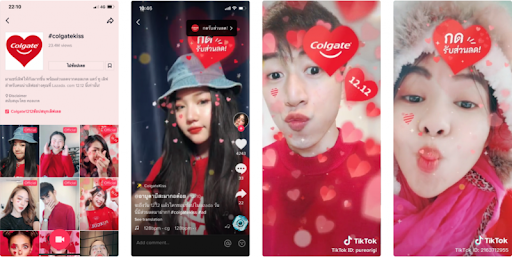
Spark Ads
Spark ads are organic posts — yours or another creator’s — which you can turn into top view or in-feed ads (with the creator’s permission, of course). TikTok users can engage with the ad as they would with an organic post — they can like, comment, share, or even create a duet.
Significantly, the conversion rate on spark ads is 43% higher than it is on other ads.
With so many ad types to choose from, it’s worth running a few tests, mixing and matching to determine what works for your brand.
If you already have a brand presence and a few organic posts that are performing well, a Spark ad is a great place to start. It’s less risky because the content is already working.
On the other hand, if you are new to TikTok and trying to build momentum, a brand takeover or a top view ad will help get you in front of people quickly, and then give you the chance to build from there.
6. Launch your product on TikTok Shop
Despite launching its social commerce product — TikTok Shop — less than a year ago, in August 2021, brands are already seeing impressive results. As with social commerce on Instagram, TikTok shop allows users to buy without ever leaving the app, simply by clicking a link the brand embeds in a live stream or video.
What sets TikTok Shop apart is that TikTok users are twice as likely as users on other platforms to comment or message a brand after purchasing. And one in four TikTok users who buy on the platform feel compelled to make a video about the product they’ve just bought – can you say #freemarketing?
The result is word-of-mouth marketing on steroids. TikTok users are 1.5 times more likely to persuade a family member or friend to try a product they’ve seen on the app.
And more and more brands are adding “As seen on TikTok” labels to their products. Bookseller Barnes & Noble even have a section on their website called BookTok.

Getting Started with TikTok Marketing Key Takeaways
If you think TikTok is just a place for teens to kill time and goof off, think again. TikTok is the fastest-growing social media platform in the world, and a cultural force of nature.
More to the point, TikTok marketing is an opportunity for brands to reach a highly engaged audience and connect with them on their own terms. As you’re getting started, keep these two key points in mind:
- Don’t take yourself too seriously. Keep your content authentic, light-hearted, and funny, and you’ll have a better chance of building a lasting and fruitful connection with your audience. Remember: start by teaching what you know.
- Most important of all, all it takes to get started is an idea and a phone! You can sign up for a business account in minutes. If you want help, or to easily repurpose the video content you already have, try out Loomly.
Stay tuned for more blogs with tactical tips on how to record and upload your first TikTok video, find influencers, make your videos shine, engage with your followers, and more!
